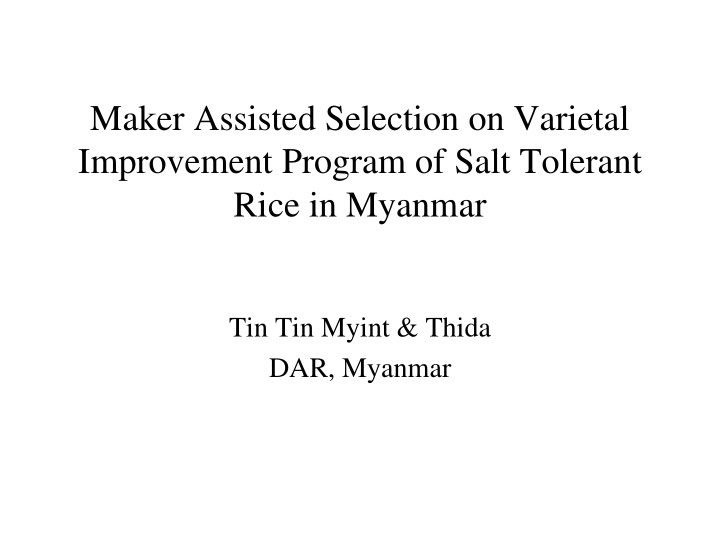



Maker Assisted Selection on Varietal Improvement Program of Salt Tolerant Rice in Myanmar Tin Tin Myint & Thida DAR, Myanmar
WORKSHOP TITLE Quick Conversion of Popular Rice Varieties with Emphasis on Drought, Salinity and Grain quality improvement RGDU, GCP & BIOTEC
Duration: 1-15 May,2008 (3 rd Training) Place : RGDU, Kasetsart University, Kamphaengsean, Nakorn Pathom, Thailand
Objectives • To develop cultivar with enhanced tolerance to prevailing salt stress • To apply the Molecular Marker Assisted Selection on advanced breeding program
Materials • Pokkali x IR53936 No.of Families • BC 4 F 2 170 leaf samples 8 • BC 3 F 5 412 leaf samples 42 • Total 582 leaf samples 50
Methods • Marker Assisted Selection • Agarose Gel Electrophoresis • Poly Acrylamide Gel Electrophoresis • Used Markers- SalT, RM 10720, RM 3412 RM 1287, RM 411, RM10772 Waxy, RM5349, RM457, RM21
Fig1-A. Breeding Program of Salt Tolerance Rice improvement � 2003 � 2008 � Year No. of families P2 P1 × 2003DS Pokkalia(salt) IR53936( HYV) F1 × IR53936 2003WS R/F&BIOTEC 2004DS BC 1 F 1 × IR53936 12 MAS (7plts) BC 2 F 1 2004WS 5 MAS × IR53936 (4plts) MAS BC 3 F 1 (22plts) 2005DS 22 BC 3 F 2 (245plts) 2005WS DAR 2006WS BC 3 F 3 (245lines)
Fig1-B. Breeding Program of Salt Tolerance Rice improvement � 2003 � 2008 � Year No. of families BC 3 F 3 (245lines) 2006WS 17 GCP&BIOTEC MAS BC 3 F 4 (77plts ) 17 2007DS BC 3 F 4 2007WS IR53936 × BC 3 F 4 MAS BC 4 F 1 2007WS 10 BC 4 F 2 BC 3 F 5 2008DS 8 , 42 MAS Evaluation for Yield Performance Test 2008WS in Target Location
Results and Discussion
BC 4 F 2 and BC 3 F 5 population of IR53936/Pokkali with SalT Marker
RM3412
RM1287
RM10772
RM411
RM457
RM5349
Table 1. Observation of salt tolerant plants on Marker Assisted Selection (2008 May) Marker Homo Homo Hetero Off- Missing Total IR PK type SalT 126 321 119 0 15 582 - - - - RM 10720 282 282 (Monomorphism) RM3412 92 403 39 34 14 582 RM411 293 10 0 0 0 303 RM1287 1 302 0 0 0 303 RM10772 0 303 0 0 0 303
Table2. . Observation of quality traits on salt tolerant introgression lines (2008 May) Total tested Homo Homo Hetero Total Marker samples IR PK Waxy 303 303 0 0 303 303 303 0 0 303 RM5349 RM457 303 303 0 0 303 RM21 303 303 0 0 303
Table 3.Selected salt tolerant plants by MAS (2008 May) No. of Tested Selected Selected Generation Progenies plants Progenies plants BC4F2 8 170 6 60 BC3F5 42 412 34 243 Total 50 582 40 303
Discussion • According to the PCR results of SalT marker, 321 homozygous plants with Pokkali gene were selected from 582 sample plants of BC 4 F 2 and BC 3 F 5 populations. • All of samples were observed in monomorphisms like IR53936 on result of Marker RM10720. • RM3412 Marker helped to select 403 homozygous plants with Pokkali gene. • 303 plants of homozygous Pokkali gene from results of both SalT and RM3412 were selected to continue for the other Markers.
Discussion • Only 10 plants were identified again from selected salt tolerant homozygous with Pokkali by use of RM411 Marker. • RM1287 and RM10772 Markers proved that 303 homozygous plants had salt tolerance like Pokkali. • Quality traits on homozygous salt tolerant lines were evaluated by use of different markers such as Waxy, RM5349,RM457and RM21. • According to these results ,all 303 samples were the same as parent IR53936 on Amylose content and Gel Temperature. • That’s why these selected lines were expected to have good eating quality with salt tolerant ability.
Future Program 1. Screening test for selected 303 lines by MAS � To use Yoshida solution culture � To test in concrete pond with salty soil 2. Evaluation for yield Performance Test � Test Entries------60 (selected lines by MAS) � Year/Season------2008 wet season � Locations--------- 2 ( kyaukse and Myaungmya Rice Research Farms) � Design-------------Augmented design � Plot size------------5 m x 0.8 m 2 (5meter × 4rows) � Spacing ----------- 20 x 20cm � Number of seeding/hill -------single � Checkes ----------- IR53936 and Pokkali � Local checkes ---- Manawthukha and Sangankhan.4.
Records 1. Yield Component and Agronomic Characters � 50% Flowering days � Plant Height (cm) � Number of productive tillers/hill � Number of total grains/panicle � Number of filled grains/ panicle � Number of unfilled grains/ panicle � 1000 grain wt(gm) � Pest and Disease � Phenotypic acceptability at maturity � Yield/Plot (gm)
Records 2. Grain Quality Analysis � Amylose Content (%) � Gel Consistency � Gel Temp: � Grain L/B ratio � Kernal Appearance � Milling recovery(%) � Eating quality 3. Score levels will be determined by use of IRRI SES
Recommend
More recommend